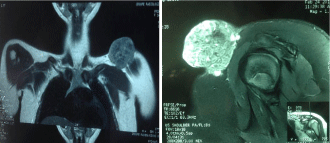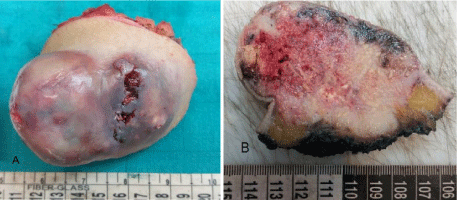
Case Report
Austin Pediatr. 2017; 4(3): 1060.
A Giant Pilomatricoma on the Left Shoulder in a 10-Year- Old Girl: A Case Report
Azami MA1*, Lamalmi N1, Oukabli M2 and Al Bouzidi A2
1Department of Pathology, Child Hospital, Mohammed V University, Rabat, Morocco
2Department of Pathology, Mohamed V military Hospital, Mohammed V University, Rabat, Morocco
*Corresponding author: Mohamed Amine Azami, Department of Pathology, Child Hospital in Rabat, Mohammed V University, Rabat, Morocco
Received: July 19, 2017; Accepted: August 10, 2017; Published: August 17, 2017
Abstract
Pilomatricoma, also known as pilomatrixoma, is a benign skin tumor arising from the cortex of a hair follicle. They are usually asymptomatic, solitary, firm or hard, freely mobile, dermal or subcutaneous nodules. The most common sites of involvement are the face and neck, followed by the upper extremities, the trunk, and the lower extremities. Pilomatrixoma are more common in children and are seen more frequently in girls. The average size is 1cm, and it very rarely exceeds 3cm in diameter. We present a case of left shoulder giant ulcerated pilomatrixoma in a 10-year-old girl with special emphasis on histopathology of pilomatricoma and the relevant differential diagnoses.
Keywords: Giant Pilomatricoma; Adnexal Neoplasm; Girl; Shoulder
Introduction
A pilomatrixoma (also called Malherbe’s calcifying epithelioma) is a benign tumor originating from hair follicle matrix cells [1]. That may occur at any age, although it is most common in childhood and adolescence and in adults over 60 years of age [2]. The tumor most commonly occurs in the head and neck region [3]. Pilomatricoma usually presents as a solitary, asymptomatic, firm, skin-colored to faint blue/red nodule and the average size is 1cm, and it very rarely exceeds 3cm in diameter [4]. The prognosis is typically good, and the treatment of choice is surgical removal.
Case Presentation
A 10-year-old girl presented with an ulcerated nodule. It was measured 9.5x6x5 cm and was located on the left deltoid region. The lesion had been present for approximately 2 years; it had rapidly increased in size and ulcerated during the last 2 months. The patient complained of occasional burning and pain. Physical examination revealed a firm but movable tumor overlying the left clavicle.
Ultrasound examination of the lesion revealed an exulcerated mass with abundant calcification and hypervascularity at the periphery of the tumor.
Magnetic Resonance Imaging showed a well-defined soft tissue mass involving the cutaneous and subcutaneous layers. It displayed iso/hypointense T1 signal to muscles, heterogeneous T2 signal and heterogeneous enhancement in post intravenous gadolinium study (Figure 1a & 1b).
Histopathologic examination of an incisional biopsy specimen revealed the hair matrix origin of the neoplasm, with shadow cells, calcification, and metaplastic ossification. Subsequently, complete surgical excision of the skin nodule was performed.
Macroscopic examination revealed a firm exophytic swelling with central ulceration (Figure 2a & 2b).
Histopathologic examination revealed a well-circumscribed neoplasm involving the whole dermis and the subcutis composed of partially confluent aggregates of matrical cells admixed with eosinophilic cornified material containing shadows cells (Figure 3a & 3b).

Figure 1: Magnetic resonance imaging picture showing a low intensity ovoid
mass in the T 1-weighted (left) with heterogeneous enhancement in post
intravenous gadolinium (right).

Figure 2(A,B): Macroscopic features of giant pilomatricoma with ulceration
(A); cut section of tumor with calcifications.
A: Hematoxylin and eosin stain x 40 magnification.
B: Hematoxylin and eosin stain, x100 magnification.

Figure 3(A,B): Pilomatricoma. The tumor consists of peripheral islands of basaloïd and ghost cells.
A: Hematoxylin and eosin stain x 40 magnification.
B: Hematoxylin and eosin stain, x100 magnification.
Discussion
Pilomatrixoma, a benign neoplasm of the hair follicle, was initially thought to arise from sebaceous glands and was called calcifying epithelioma of Malherbe by Malherbe and Chenantais [5]. It typically presents as a solitary, slow growing, firm, dermal or subcutaneous nodule, frequently occurring in the head, neck, and upper extremities [6].
Pilomatrixomas are usually solitary, but multiple foci have been reported in 3.5% of all cases. Familial pilomatrixomas and multiple familial pilomatrixomas are much rarer. Multiple pilomatrixomas and multiple familial pilomatrixomas have been associated with myotonic dystrophy [7] Gardner syndrome, [8] and Rubinstein- Taybi syndrome [9].
The size of the tumor is usually <3cm, and the term giant pilomatrixoma has been used for lesions >5 cm in diameter. There have been very few reported cases of giant pilomatrixoma >10cm [10].
Radiologically, Plain X-ray films have limited utility, but may detect calcific foci. The characteristic sonographic picture of pilomatrixoma is an ovoid mass with echogenic center surrounded by a hypoechoic rim with acoustic shadowsat the junction of dermis and subcutaneous fat with focal thinning of overlying dermis. It also shows calcification [11,12].
Computed tomography demonstrates a sharply demarcated, subcutaneous lesion of soft tissue density, with or without calcification. MRI may show a rim-enhancing lesion with small areas of signal dropout which may be consistent with calcifications [13].
The microscopic appearance of pilomatricoma is characterized by irregularly shaped well-circumscribed masses of epithelial cells. Basophilic cells and shadow cells may be observed in the cellular stroma. Areas of keratinization, calcification and ossification may are seen in the stroma. The stroma often contains a chronic inflammatory cell infiltrate with foreign body giant cells. Mitotic figures may be numerous. Active proliferating hyperchromatic cells with numerous mitoses and infiltration of surrounding structures are microscopic features suggestive of malignant pilomatricoma [14,15].
Spontaneous regression of pilomatrixoma has not been reported. Surgical excision is the primary treatment for pilomatrixoma. However, there is no standard surgical margin for excision. A narrow excisional margin is generally necessary for complete removal of typical lesions, whereas a wide excision margin of 1–2 cm with preoperative diagnostic imaging has been recommended for giant Pilomatrixoma [16,17].
References
- Lan MY, Lan MC, Ho CY, Li WY, Lin CZ. Pilomatricoma of the head and neck: a retrospective review of 179 cases. Arch Otolaryngol Head Neck Surg. 2003; 129: 1327-1330.
- Julian CG, Bowers PW. A clinical review of 209 pilomatricomas. J Am Acad Dermatol. 1998; 39: 191–195.
- Yencha MW. Head and neck pilomatricoma in the pediatric age group: a retrospective study and literature review. Int J Pediatr Otorhinolaryngol. 2001; 57: 123-128.
- Ismail W, Pain S, al-Okati D, et al. Giant pilomatricoma simulating carcinoma of the male breast. Int J Clin Pract. 2000; 54: 55-56.
- Kawamura N, Tamura H, Obana S, Wenner M, Ishikawa T, et al. Differential effects of neuropeptides on cytokine production by mouse helper T cell subsets. Neuroimmunomodulation.1998; 5: 9-15.
- 6.Danielson-Cohen A, Lin SJ, Hughes CA, et al. Head and neck pilomatrixoma in children. Arch Otolaryngol Head Neck Surg. 2001; 127: 1481–1483.
- Cantwell AR, Reed WB. Myotoniaatrophica and multiple calcifying epithelioma of Malherbe. ActaDermVenereol. 1965; 45: 387-390.
- Pujol RM, Casanora JM, Egido R, Pujol I. Multiple familial pilomatrixoma: a cutaneous marker for Gardner syndrome? PediatrDermatol. 1994; 12: 331-335.
- Cambiaghi S, Ermacora L, Brusasco A, Canzi L, Caputo R. Multiple pilomatricomas in Rubinstein-Taybi syndrome: a case report. PediatrDermatol. 1994; 11: 21-25.
- Yamauchi M, Yotsuyanagi T, Saito T, et al. Three cases of giant pilomatrixoma – considerations for diagnosis and treatment of giant skin tumours with abundant inner calcification present on the upper body. J PlastReconstrAesthet Surg. 2010; 63: 519–524.
- Hughes J, Lam A, Rogers M. Use of ultrasonography in the diagnosis of childhood pilomatrixoma. Pediatr Dermatol. 1999; 16: 341-344.
- Hwang JY, Lee SW, Lee SM. The common ultrasonographic features of pilomatricoma. J Ultrasound Med. 2005; 24: 1397-1402.
- Agarwal RP, Handler SD, Matthews MR, Carpentieri D. Pilomatrixoma of the head and neck in children. Otolaryngol Head Neck Surg. 2001; 125: 510-515.
- Fayyazi A, Soruri A, Radzun HJ, Peters JH, Berger H. Cell renewal, cell differentiation and programmed cell death (apoptosis) in pilomatrixoma. Brit J Dermatol. 1997; 137: 714-720.
- Kaddu S, Soyer HP, Hödl S, Kerl H. Morphological stages of pilomatricoma. Am J Dermatopathol. 1996; 18: 333-338.
- Duflo S, Nicollas R, Roman S, et al. Pilomatrixoma of the head and neck in children: a study of 38 cases and a review of the literature. Arch Otolaryngol Head Neck Surg. 1998; 124: 1239–1242.
- Kovacic M, Rudic M, Nekic I, et al. Giant pilomatrixoma (benign calcifying epithelioma of Malherbe) of the neck and face. Dermatol Surg. 2007; 33: 340–343.